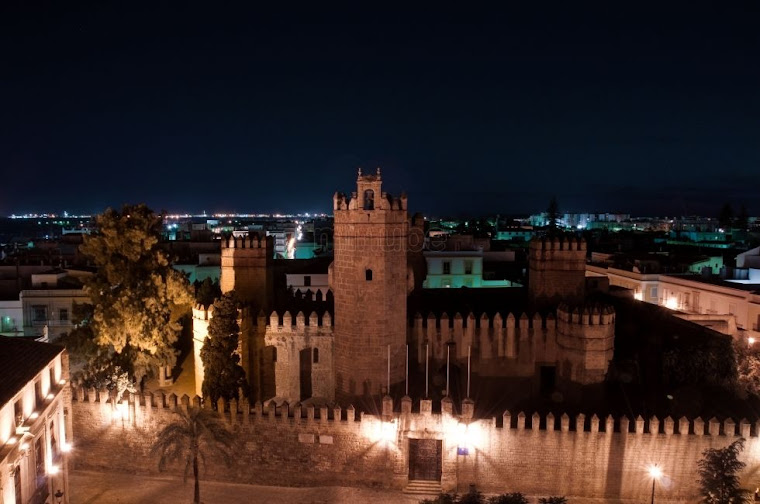One of the things I love most about being in the middle of El Puerto de Santa Maria, or Puerto, as it is known here, is the accessibility of everything here. My cousin Sophie is not as impressed, having grown up in Germany where she regularly walks through charming pedestrian zones and past 300-year-old churches. But I just can’t get enough of it. As we travel out to different towns and cities within a two-hour drive, we continue to walk through some of the most exquisite narrow, winding streets imaginable.
 |
| Walking to school in Puerto |
Our first trip, easy to do because the ferry is just two blocks from our house, was to Cádiz. A lovely twenty-minute boat ride across the Bay lands you in a city founded by the Phoenicians in 1100 B.C. and which is the most ancient city still in existence in Western Europe. Although little is left of the Romans, who conquered it in 200 B.C., and of the Moors, who occupied it from 700 to 1200 A.D., there IS a lot of beautiful 18th and 19th century architecture. The cathedral has a dramatic view of the Atlantic, and you can leisurely walk around the city on the sea walls in a couple of hours.
 |
| Steph atop El Catedrál de Cádiz |
Our second trip, after exploring Puerto, was to Sevilla, an easy 90-minute drive or 80 minutes on the train. Sevilla is one of Spain’s most iconic cities, a province of Andalusia (where we live in Southern Spain), and home to many things considered “Spain:” bullfighting, flamenco, tiny winding streets, huge iberico bellota jamones hanging from the ceilings of tapas bars. It was my favorite city when Todd and I traveled through here in 1987; it continues to enchant. Absolutely gorgeous and not to be missed is the Alcazar, Pedro the Cruel’s palace which has been added onto over the centuries, but which has not lost its Moorish roots.
 |
| Patio de las Doncellas, El Alcazar, Sevilla |
 |
| The Moorish stonework is breathtaking |
Out on the coast, we visited Bolonia, a tiny town about an hour south. There the beach is gorgeous and windswept, with a collection of white sand dunes. It is near the site of the ancient Roman city of Baelo Claudia, which has been excavated over the years by numerous archaeologists, two of whom are Luis and Conchi, our friends from La Casa Rosa (see post from August!). They met while working at Baelo Claudia, and the entrance to their house, La Casa Rosa, contains the head of a replica of a Roman statue they uncovered there. We wandered through the ruins on well-marked paths, Tia and Sasha climbing freely over millennia-old walls, all of us engaged in speculating what went on in that little fishing village.
 |
| View to the Atlantic through Roman ruins |
Among the little treasures of this area are the Pueblos blancos, or White Villages, which hang on the cliffs of the mountainous interior of Andalucia. Arcos de la Frontera is closest to us and was our first visit, although we made the classic tourist mistake of arriving at 2 pm, with everything—everything-- shut down for the siesta. We wandered the streets and found a lovely Moroccan restaurant, but didn’t see much else except a lonely tourist shop up by the Cathedral.
 |
| A Pueblo Blanco: Arcos de la Frontera |
But our second visit to a pueblo blanco was amazing, this time to the town of Ronda. Home to Ernest Hemingway’s For Whom the Bell Tolls and one of his favorite hangouts, home of the Romero family who founded modern-day bullfighting and home to the oldest bullring in Spain, and home to three bridges spanning the jaw-dropping El Tajo cut by the Guadalevín River, Ronda delights the eye and defies the American propensity to safety-proof everything.
 |
| Ronda, photo courtesy of Sasha! |
White houses and buildings line the gorge, balanced precariously on the edge, and a path leads down into the gorge. Todd didn’t like it; after a sloping stone-lined path, the way down began to traverse old walls no more than two feet wide, with steep drops of 20 feet+ on either side. You could see there used to be a kind of guardrail, but it had long since rotted away. Side paths wandered off, slick with mud and weeds, ending abruptly at nothing. Water poured from an ancient spillway, our path separated from it by a wobbly chain-link fence with a foot-wide gap at the bottom.
 |
| Todd (with Man-purse) keeps the girls safe. |
Needless to say, Tia and Sasha were entranced by the fairy-tale view of the small rushing river dwarfed by the immense footings of the Puento Nuevo, which rise to the top of the gorge to form a bridge, built from 1751 to 1793 (when you see it, you realize why it took them so long to complete it!). We walked down into the gorge twice: once during the day, right after we arrived, and once more in the evening, when the long shadows made the sloping path through the fruit orchards and long grass magical and the massive lighting illuminated the bridge.
 |
| Ronda's Puento Nuevo at night |
Next stop coming shortly: Granada, home to Moorish culture and ski slopes!









